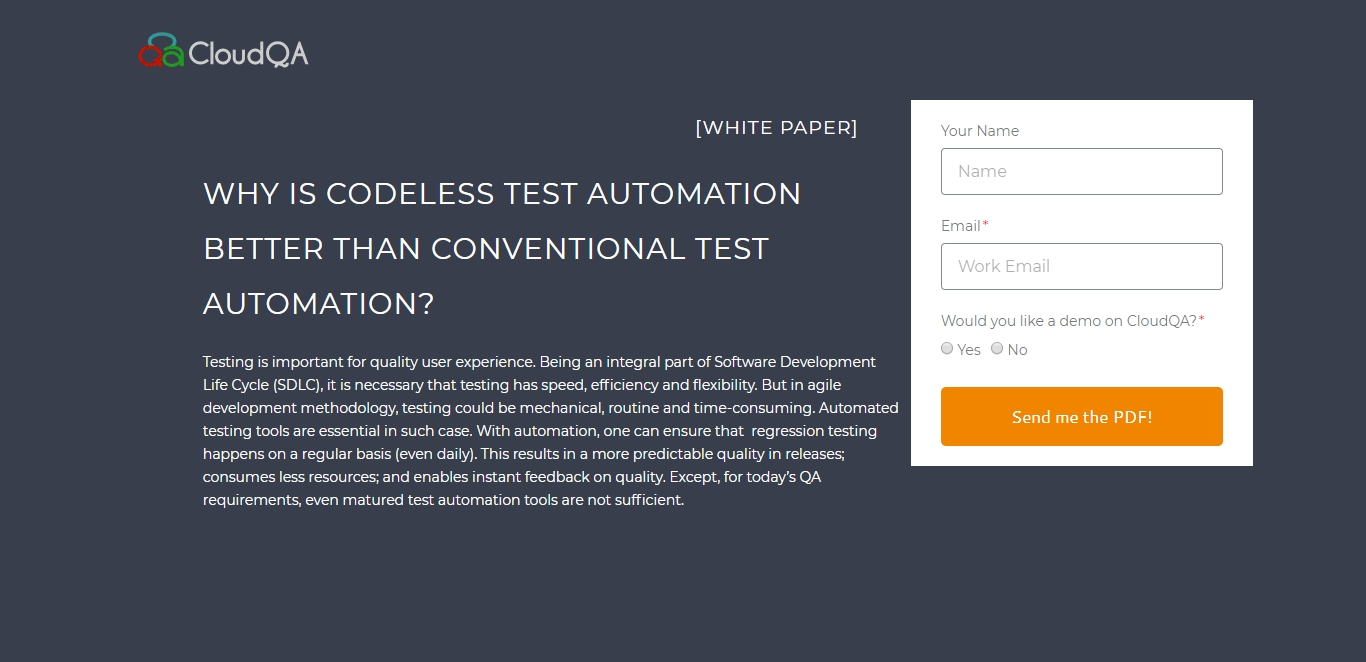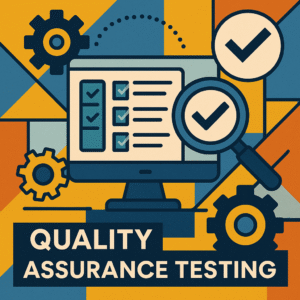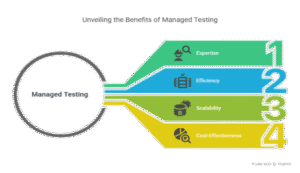What is Cloud Based testing and Why should you be doing it?
Last Updated: November 25th 2025
Ready to eliminate your testing bottleneck? Don’t let outdated infrastructure slow down your releases. Discover how TruRT’s cloud-based platform can help you scale your testing efforts, cut costs, and ship higher-quality software, faster.
Table of Contents

What is Cloud Based Testing?
Cloud-based testing is a method of software testing that uses cloud infrastructure to simulate real-world user environments. Instead of buying and maintaining your own expensive physical servers and devices, you access a ready-made testing environment over the internet from a third-party provider. This allows your team to run tests on thousands of different browser, operating system, and device combinations on-demand, paying only for the resources you use. Essentially, it’s a way to ensure your software works for all users without the massive cost and effort of building your own test lab.
The Bottom Line Up Front: The Core Advantages of Cloud Testing
Before we dive deep, let’s summarize the primary benefits that directly answer why moving your QA to the cloud is a strategic imperative.
A recent market analysis projects the global cloud testing market to reach $29.1 billion by 2028, growing at a CAGR of 13.5%. This rapid adoption is fueled by the clear and compelling ROI businesses are realizing from moving away from on-premise solutions.
Here are the key benefits at a glance:
Benefit | Impact on Your Business |
Drastic Cost Reduction | Eliminates capital expenditure (CapEx) on hardware and reduces operational costs. |
Massive Scalability | Instantly scale testing resources up or down to meet project demands without delay. |
Increased Test Coverage | Test across thousands of browser, OS, and device combinations for superior quality. |
Accelerated Speed | Run hundreds of tests in parallel to get feedback in minutes, not hours. |
Enhanced Collaboration | Provides a centralized platform for distributed QA and development teams to work together seamlessly. |
A Deep-Dive on Cost-Effectiveness: OpEx vs. CapEx
The most immediate and quantifiable benefit of cloud-based testing is the dramatic reduction in cost. This is achieved by shifting from a Capital Expenditure (CapEx) model to an Operational Expenditure (OpEx) model.
The Old Way: The On-Premise Cost Burden
With traditional on-premise testing, the costs are substantial and front-loaded:
- Hardware Purchase: You have to buy, set up, and house physical servers, devices, and networking equipment. This is a significant upfront CapEx investment.
- Software Licensing: Expensive licenses are often required for operating systems and specialized testing software.
- Maintenance & Staffing: You need dedicated IT staff to maintain, patch, and upgrade the hardware and software.
- Energy & Space: Physical servers consume a large amount of power for operation and cooling and require dedicated physical space.
- Underutilization: A significant portion of this expensive infrastructure sits idle between testing cycles, yet the costs of power, maintenance, and depreciation continue to accrue.
The New Way: The Cloud Pay-As-You-Go Model
Cloud testing platforms eliminate these costs entirely.
- No Hardware to Buy: The cloud provider owns and manages all the infrastructure. There is zero CapEx.
- Pay for What You Use: With an OpEx model, you only pay for the testing resources you consume, when you consume them. Need to run 100 parallel tests for two hours? You pay only for those two hours.
- Reduced Staffing Overhead: Your IT and QA teams can focus on quality assurance, not infrastructure management.
- Eliminated Maintenance: All maintenance, security, and upgrades are handled by the cloud provider.
The Bottom Line: For most organizations, switching to cloud testing can reduce the total cost of ownership (TCO) for their testing infrastructure by 40-60%.
Unmatched Scalability and Flexibility
Your testing needs are not static. They fluctuate dramatically based on project timelines, release schedules, and application complexity. Cloud-based testing is built for this reality.
Scaling On-Demand
Imagine you need to test your application’s performance under a load of 50,000 concurrent users. With an on-premise setup, this would require a massive, expensive hardware investment that might only be used a few times a year.
With a cloud-based QA platform, you can provision the necessary virtual resources in minutes, run your large-scale performance test, and then de-provision them just as quickly. This elasticity means you have access to virtually unlimited resources, precisely when you need them, without any long-term commitment.
Increasing Test Coverage for Higher Quality
Scalability isn’t just about performance; it’s about coverage. Your customers access your application from a dizzying array of devices, browsers, and operating systems. Replicating this in an on-premise lab is practically impossible.
Cloud testing platforms provide instant access to thousands of real and virtual environments. With a few clicks, your QA team can:
- Execute cross-browser testing on the latest versions of Chrome, Firefox, Safari, and Edge.
- Validate mobile compatibility across hundreds of real iOS and Android devices.
- Ensure performance on different operating systems like Windows, macOS, and Linux.
This ability to easily run tests across a vast test matrix results in higher-quality software, fewer escaped bugs, and a better customer experience.
Accelerating Testing Cycles with Parallel Execution
Speed is a critical competitive advantage. The faster you can get feedback from your tests, the faster you can release new features. This is where parallel testing on the cloud becomes a game-changer.
Sequential vs. Parallel Testing
- Sequential Testing: In a traditional setup, if you have a regression suite of 500 tests and each test takes 1 minute to run, the entire suite takes over 8 hours to complete. This is a massive bottleneck in a CI/CD pipeline.
- Parallel Testing: In the cloud, you can run all 500 of those tests at the same time on 500 different virtual environments. The entire suite now completes in just 1 minute.
This massive acceleration means that developers get feedback almost instantly after committing new code. Bugs are found earlier when they are cheaper to fix, and the entire development lifecycle speeds up. For teams practicing continuous integration and continuous deployment (CI/CD), the speed of parallel testing in the cloud is not just a benefit—it’s a necessity.
Enhanced Collaboration for Distributed Teams
Software development is a team sport, but team members are often spread across different offices, time zones, and even continents. Cloud-based testing platforms act as a centralized hub that breaks down geographical barriers.
- Single Source of Truth: All test scripts, environments, and results are stored in one central, accessible location. A developer in the US, a QA engineer in India, and a product manager in Europe can all view the exact same test run and its results in real-time.
- Seamless Integration: Cloud testing tools integrate directly with other collaboration and development tools like Jira, Slack, and GitHub. When a test fails, a ticket can be automatically created in Jira and assigned to the right developer, with a link to the test results and a video recording of the failure.
- No More “It Works on My Machine”: Because everyone is testing on the same standardized cloud environments, you eliminate the classic problem where a bug cannot be reproduced because of differences in local machine configurations.
This level of integrated collaboration leads to faster bug resolution, less miscommunication, and a more efficient and cohesive team.
Frequently Asked Questions (FAQ) Section
1. What is the difference between cloud-based testing and on-premise testing?
The primary difference is where the testing infrastructure resides. In on-premise testing, your company owns, houses, and maintains all the physical servers and devices in your own data center. In cloud-based testing, you access a testing infrastructure that is hosted and managed by a third-party vendor (like CloudQA) over the internet, paying only for the resources you use.
2. Are there any disadvantages to cloud-based testing?
While the benefits are overwhelming, there are considerations. The main one is security and data privacy. When testing with sensitive production data, you must ensure the cloud provider has robust security protocols, data encryption, and complies with regulations like GDPR or HIPAA. Reputable providers offer secure, private cloud options to mitigate these risks. Another consideration is the reliance on an internet connection.
3. What types of testing can be performed in the cloud?
Virtually any type of software testing can be performed more efficiently in the cloud. This includes:
- Functional & Regression Testing
- Performance, Load, and Stress Testing
- Cross-Browser & Mobile Device Compatibility Testing
- API Testing
- Security Testing
- Localization Testing
4. Is cloud testing only for large enterprises?
Absolutely not. In fact, cloud testing is arguably more beneficial for startups and small to mid-sized businesses (SMBs). SMBs often lack the capital to invest in expensive on-premise infrastructure. Cloud testing gives them immediate access to a world-class testing environment with a predictable, pay-as-you-go cost model, leveling the playing field and allowing them to compete with larger companies on software quality.
5. How does cloud testing integrate into a CI/CD pipeline?
Cloud testing platforms are designed for CI/CD integration. They typically offer plugins or API integrations with popular CI tools like Jenkins, GitLab CI, CircleCI, and GitHub Actions. When a developer commits new code, the CI tool automatically triggers a build, and then calls the cloud testing platform to run the relevant regression suite in parallel. The results are sent back to the CI tool, which can then decide whether to pass the build and proceed with deployment or fail it and notify the team. This creates a fully automated and highly efficient “code-to-cloud” workflow.
LIKE THIS POST SHARE IT WITH YOUR FRIENDS
RECENT POSTS
Guides

How To Select a Regression Testing Automation Tool For Web Applications
Regression testing is an essential component in a web application development cycle. However, it’s often a time-consuming and tedious task in the QA process.

Switching from Manual to Automated QA Testing
Do you or your team currently test manually and trying to break into test automation? In this article, we outline how can small QA teams make transition from manual to codeless testing to full fledged automated testing.

Why you can’t ignore test planning in agile?
An agile development process seems too dynamic to have a test plan. Most organisations with agile, specially startups, don’t take the documented approach for testing. So, are they losing on something?

Challenges of testing Single Page Applications with Selenium
Single-page web applications are popular for their ability to improve the user experience. Except, test automation for Single-page apps can be difficult and time-consuming. We’ll discuss how you can have a steady quality control without burning time and effort.

Why is Codeless Test Automation better than Conventional Test Automation?
Testing is important for quality user experience. Being an integral part of Software Development Life Cycle (SDLC), it is necessary that testing has speed, efficiency and flexibility. But in agile development methodology, testing could be mechanical, routine and time-consuming.





